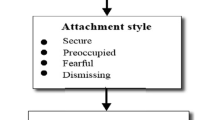Abstract
In exploring the relationship between defense reactions and coping strategies in a non-clinic sample of adolescents (N = 81), we assessed: defense structure by the Bond Defense Style Questionnaire (DSQ); coping behaviors by the Coping Responses Inventory-Youth Form (CRI-Youth); and general adjustment by Global Assessment of Functioning (GAF) ratings. Defense reactions and coping strategies were modestly associated and made independent contributions in predicting the GAF. Mature and immature defenses and avoidance coping comprised the optimal combination in predicting the GAF, accounting for 20% of GAF variance. It is therefore important to assess both unconscious and conscious processes when assessing general functioning in normal adolescents.
Similar content being viewed by others
References
Lazarus r, Folkman, S: Stress, appraisal, and coping. New York: Springer Publishing Company, 1984.
Feldman S, Araujo K, Steiner H: Defense mechanisms in adolescents as a function of age, sex, and mental health status. In print.
Vaillant G: Adaptation to life. Canada: Little, Brown & Co., 1977.
Steiner, H: Defense styles in eating disorders. Int J Eating Disord 9: 141–151, 1990.
Bond M, Gardner S, Christian J, Sigal C: Empirical study of self-related defense styles. Arch Gen Psychiatry 40:333–338, 1983.
Andrews G, Pollock C, Stewart G: The determination of defense style by questionnaire. Arch Gen Psychiatry 46:455–460, 1989.
Vaillant G: Theoretical hierarchy of adaptive ego mechanisms: a 30 year follow-up of men selected for psychological health. Arch Gen Psychiatry 24:107–117, 1971.
Moos R: Coping Response Inventory-Adult Form professional manual. Odessa FL: Psychological Assessment Resources, 1993.
Steiner H, Feldman S: Two approaches to the measurement of adaptive style: a comparison of normal, psychosomatically ill, and delinquent adolescents. J Am Acad Child Adolesc Psychiatry 34: 180–190, 1995.
Moos R: Coping Response Inventory-Youth Form professional manual. Odessa FL: Psychological Assessment Resources, 1993.
American Psychiatric Association: Diagnostic and statistical manual of mental disorders, third edition, revised. Washington, DC: American Psychiatric Press, 1987.
Endicott J, Spitzer R, Fleiss J, Cohen J: The global assessment scale. Arch Gen Psychiatry 33, 766–771, 1976.
Feldman S, Elliott G: At the threshold:The developing adolescent. Cambridge, MA: Harvard University Press, 1993.
Author information
Authors and Affiliations
Rights and permissions
About this article
Cite this article
Erickson, S., Feldman, S.S. & Steiner, H. Defense Reactions and Coping Strategies in Normal Adolescents. Child Psychiatry Hum Dev 28, 45–56 (1997). https://doi.org/10.1023/A:1025145119301
Issue Date:
DOI: https://doi.org/10.1023/A:1025145119301



